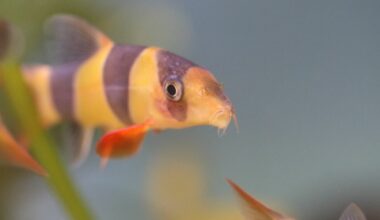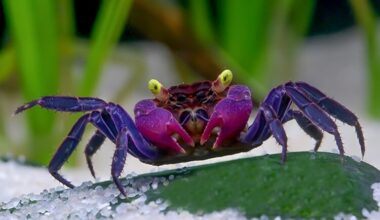Fiddler Crabs are an awesome pet that we recommend all the time. Their cute appearance and fun personality make them a joy to own!
These critters have been quite a popular pet option over the years, and it doesn’t seem like that’s going to change anytime soon.
But if you’re one of the many people interested in these crabs, there are some things you need to understand first. While these pets are quite hardy, they do require some unique conditions in order to thrive in captivity.
To make things easy, we made sure to cover all the essentials of Fiddler Crab care in this guide. By the time you’re done reading it, you’ll be familiar with their habitat, tank setup, diet, tank mates, and other helpful facts!
Table of Contents
Species Summary
If you’re looking for a fun alternative to fish for your home aquarium, consider the Fiddler Crab! These small crustaceans are energetic creatures with unique habitat needs.
Technically speaking, the name “Fiddler Crab” refers to roughly 100 closely related species and subspecies. They all belong to the Ocypodidae family and have similar needs.
Fiddler Crabs come from coastal regions all around the world. Many of the crabs in the pet trade today come from Florida, where they inhabit shores, lagoons, and swamps. You can usually find the crabs hiding in burrows along the shoreline or scavenging for food beneath the tide.
In captivity, Fiddler Crabs are very hardy and easy to care for. They make great pets for those wanting something a bit sturdy out of the box.
Lifespan
The average Fiddler Crab lifespan is between two and three years in captivity. However, that’s only with proper care and good living conditions.
Despite their hardy nature, Fiddler Crabs are not immune to health problems. In a poorly maintained environment, these crustaceans can suffer and die prematurely.
Appearance
There are many different kinds of Fiddler Crabs out there. They come in a wide range of colors and a handful have unique patterns that help them stand out even more!

That said, all Fiddler Crabs have the same basic appearance. They’re small crabs with a tough carapace (this is the outer shell that protects all of the internal organs).
These crabs are decapods. They have ten feet that help them make their way through the land and swim in the water. The most identifiable feet are going to be their two front claws.
The females have two small claws. However, the males have one massive claw. For most specimens, the large claw is significantly bigger than their entire body!
Author Note: These massive claws have a number of interesting uses. Fiddler Crabs use them for self-defense and communication (more on that later).
Beyond their signature claw, Fiddler Crabs have stalked eyes and a pair of antennae. Most Fiddler Crab species also have a beak-like structure on the from of their shell called the rostrum.
Average Size
The average size of a Fiddler Crab is only about 2 inches wide. These are very small crustaceans!
Author Note: Many potential owners are surprised to find out that these aren’t massive crabs. There’s something about seeing them in pictures that makes them seem larger than they really are!
Fiddler Crab Care
Fiddler Crab care is quite easy compared to a lot of other invertebrates out there. These critters adapt well to life in captivity and can stay pretty healthy in most situations.
Of course, you still need to address their core needs! These creatures are unique and require a very specific environment if you want them to truly thrive (which should be your goal with any pet).
Here are some care guidelines to help you out:
Tank Size
The good news is that Fiddler Crabs don’t need a ton of room. A group of up to four crabs can live very comfortably in a simple 10-gallon aquarium.
A standard aquarium will do just fine. Just make sure it has a stable lid! A mesh top is best, as it will provide ample air circulation throughout the habitat.
Author Note: If you want to keep a larger group, provide about five extra gallons for each additional crab.
Water Parameters
For many owners, this can be one of the trickier parts of Fiddler Crab care. These crabs are often marketed as freshwater pets (we even included them on our freshwater crab list).
However, they don’t live in pure freshwater environments in the wild.
To replicate their natural habitat, you must provide brackish water. Brackish water has low salinity, but it’s far from freshwater. Use a hydrometer to find the appropriate level. It’s also a good idea to check salinity levels regularly to avoid any issues (especially early on).
Once you get the following parameters just right, your Fiddler Crabs will be much happier.
- Water temperature: Between 75°F and 85°F
- pH levels: 8.0 to 8.3
- Water hardness: 12 to 30 KH
- Specific gravity: 1.005 to 1.08 (below 1.01 is best for most species)
Tank Setup
Another common misconception about Fiddler Crabs is that they don’t need land in their habitat! These crabs spend a lot of time in the water, but they also burrow in the sand. In fact, they’ll often burrow a home in the sand along the shore and retreat to the water when tides go up.
To create a similar environment in your tank, you’ll need to build an artificial shore with your substrate.
You can use fine sand or aragonite substrate. The aragonite is great for maintaining pH levels and providing the crabs with trace minerals.
Author Note: Don’t use gravel. Gravel can injure the crab. Plus, it’s next to impossible for the crabs to burrow or scavenge.
Using the substrate, create a gradual slope to one side of the tank. The water doesn’t need to be more than a few inches deep, so making a shoreline shouldn’t be too difficult.
In the water, you can add some rocks or driftwood. These decorations will give the crabs somewhere to climb when they’re in the water. Small plants are good for their setup too.
To keep the water portion of the tank clean, add an internal filter. Don’t use a hang-on-back model, as the crabs can climb up and escape the tank.
Finally, you need a way to keep the water well-aerated. You can use a simple air bladder. Alternatively, you can position the filter outlet to create some movement that simulates waves.
Common Possible Diseases
Health issues aren’t very common with Fiddler Crabs in captivity. However, they can still suffer from diseases caused by poor living conditions.
If you let the tank get too dirty, the water conditions will fluctuate. This can lead to shell diseases. Bacteria, fungus, and viruses can damage the shell, which eventually causes internal health concerns.
Stay on top of the water conditions in the tank. To keep the water in good shape, clean out your filter regularly. It’s also good to change about 20 percent of the water every few weeks for good measure.

Fiddler Crabs may also experience problems during molting. The crabs molt every eight weeks or so as they grow. During this time, the crab might slow down and not eat.
They’re vulnerable after molting, as the new shell is still soft. Just be patient and your crab should return to normal.
Author Note: Many Fiddler Crabs will lose a limb at some point in their life. If this happens, the crab should regrow a new limb when they molt.
Fiddler Crab Food & Diet
Fiddler Crabs are natural-born scavengers. They’re omnivores that will eat anything they can find!
When they eat, these crabs will use their claws to put substrate in their mouth. They then sift through the substrate and eat the organic matter. This includes algae, fungus, and tiny insects.
Dry foods are readily available and a viable option for Fiddler Crabs as well. The food is formulated to provide all of the nutrients the crabs need. Just drop some pellets or flakes into the water and watch the crabs find them.
If you want to supplement the dry food, you can provide plankton, brine shrimp, seaweed, blanched zucchini, and bloodworms. The crabs will also eat their old shell after molting, so don’t be so quick to remove it!
Feed your crabs once a day. If there are any leftover foods the next day, remove them to prevent the water quality from deteriorating.
Behavior & Temperament
Fiddler Crabs never get boring, which is one of the reasons they make such great pets!. These critters are very active and can scurry across the sand very quickly. Oftentimes, you’ll find them digging burrows or crawling beneath the surface of the water.
As they dig their burrows, they’re actively scavenging at the same time. You might see the crabs spitting out tiny little sand balls as they search for food.
Aggression isn’t a huge problem with Fiddler Crabs. Sometimes, males can get a bit territorial. They can also get into disputes over a female. If push comes to shove, they could end up fighting and losing a limb or two.
To avoid this, simply remove the aggressors and keep them in separate tanks.
Author Note: One cool behavioral quirk you can observe is waving! Fiddler Crabs will wave their big claw to communicate. This behavior alerts others of their presence.
Tank Mates
Fiddler Crabs do best in small groups of at least two. As long as you have ample space inside the tank, a larger group shouldn’t be an issue.
These crabs are highly sociable and enjoy the company of others.
As for other tank mates, you have limited options. Not too many fish will survive in the brackish waters Fiddler Crabs need. Furthermore, these crabs will try to catch the fish for food!
If you want to keep fish in the tank, stick to fast-moving that can get away from the crab’s claw. Some owners have seen success with Guppies, Mollies, Bumblebee Gobies, and Swordtails.
Keep in mind that the fish will need more than a few inches of water to stay healthy, so you’ll need to adjust your tank setup a bit.
Other invertebrates, such as snails or shrimp, might work. However, the risk of the crab hunting them down is still present.
Simply put, Fiddler Crabs do best in a single-species tank. You can try adding tank mates but keep a watchful eye to ensure their safety.
Breeding
Successfully breeding Fiddler Crabs in captivity is impossible. You might see the males and females performing a courtship dance. The female may even start developing eggs!
However, the breeding cycle for Fiddler Crabs is far more complicated than what you can achieve in an aquarium.
The Fiddler Crab larvae develop in deep ocean waters. They make their way to the shoreline as they approach maturity.
There’s simply no way to recreate the required environment in captivity, so the eggs will never develop into crabs.
Closing Thoughts
Fiddler Crabs are a fantastic pet to own, and we recommend them to other people all the time. Watching these little critters go about their business never gets old!
As long as you have a handle on their main care requirements (particularly in regard to their tank setup) you shouldn’t have trouble keeping them as pets. These crabs are about as low-maintenance as it gets.
If you have questions about any particular species of Fiddler Crab, we’re always happy to help. For the most part, the high-level care recommendations will hold true. But it’s always smart to double-check!

